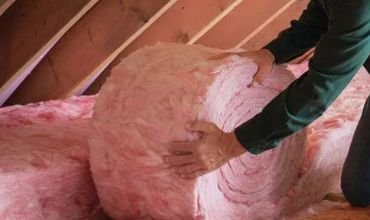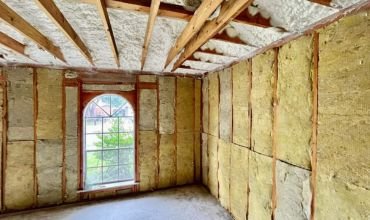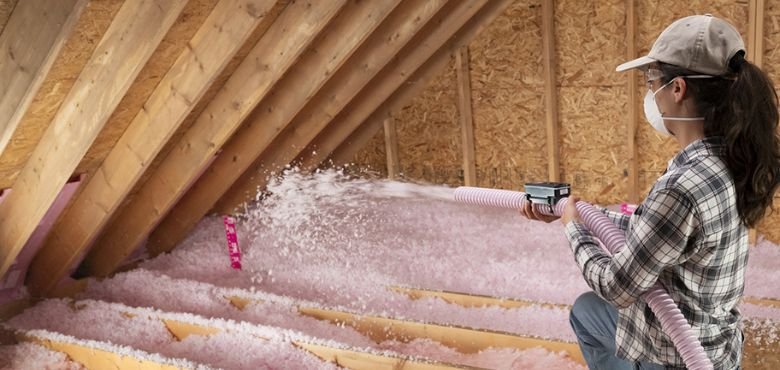Did you know that up to 40% of heat loss can happen via your attic? That’s a lot of wasted energy! A properly protected attic can remarkably lower your power bills, improve your home’s comfort, etc. Without attic insulation, heat can exit through the roof, making your home feel uncomfortable. And when it’s hot outside, the heat can leak into your attic and make your whole house feel like an oven. That’s why this is so important. It helps to create a more comfortable and energy-saving home.
Not only does it make your home more comfortable, but it can also save you money on your energy bills. When your attic is properly insulated, your heating and cooling system doesn’t have to work as hard to maintain a comfortable temperature so, if you’re looking for a simple way to improve your home’s comfort and save money.
What is Attic Insulation?

Attic insulation is a material used to protect a building’s attic space. It’s a thermal barrier that helps control the temperature in your home. By preventing heat from escaping during the winter and keeping cool air in during the summer, it helps improve energy efficiency and reduce heating and cooling costs.
Different types of insulation for attic include fiberglass, rock wool, cellulose, and spray foam. Each has its special features. For example, fiberglass is popular because it’s affordable and easy to install. Rockwool is excellent at stopping fire and noise. Cellulose is made from recycled paper and is good at preventing air leaks. Spray foam attic insulation is a thick, airtight material that provides excellent insulation and can help seal air leaks.
Attic Insulation Options: Which is Best for You?
Choosing the correct type is crucial for maximizing energy efficiency, improving comfort, and increasing your home’s value. With so many options to choose from, it’s important to know the pros and cons of each. Knowing about the different types of attic insulation helps you make an informed decision.
Fiberglass Insulation
Fiberglass insulation is one of the most common and affordable attic insulation. It’s made from thin glass fibers bonded together with resin. Fiberglass insulation is simple to install, as it’s available in batts and rolls. It also helps decrease heat transfer and improve energy efficiency.

Rockwool Insulation
Rockwool is a stone-based insulation material made from volcanic rock. It’s known for its excellent fire resistance, soundproofing properties, and durability. Commercial buildings and homes in areas with high fire risks often use it.
Cellulose Insulation
People treat recycled paper products with fire retardants and boric acid to make cellulose insulation. It’s a highly effective material that can help reduce air leakage and improve energy efficiency. Cellulose insulation is often blown into attics using specialized gear.
Spray Foam Insulation
Spray foam insulation is a dense, airtight material applied as a liquid and grows to form a solid foam. It’s known for its excellent insulation properties and can help seal air leaks, making it a popular choice for new construction and renovations. However, spray foam can be more costly than other types of insulation.
How to Choose the Right Insulation for Your Attic?
Choosing the proper insulation for your attic is important for saving energy, improving comfort, and increasing your home’s value. Select the best option for your specific needs.
Assess Your Attic’s Condition

A thorough inspection is important to ensure the best attic insulation. Start by carefully examining the attic for any air leaks, which can be sealed to prevent drafts and enhance insulation efficiency. Also, check for signs of moisture, as extreme humidity can lead to mold and rot. Finally, the insulation’s thickness gets measured to determine the current level.
Consider Your Climate
Insulation with a higher R-value is essential for cold climates to fight heat loss effectively. This means your home will have warmth more efficiently, decreasing heating costs and improving comfort. This type of insulation helps keep your home cool by minimizing heat absorption, leading to lower cooling costs and a more comfortable living environment.
Determine Your Budget
When setting a budget, consider your overall home improvement goals. While high-quality insulation may have a higher cost, its long-term energy savings can make it a beneficial investment.
Evaluate Your Home’s Construction
Due to their age and construction materials, older homes often require insulation solutions to improve energy efficiency. While newer homes might have modern insulation standards, older structures may benefit from upgrades or more insulation layers. Proper ventilation is also necessary to control moisture buildup and maintain a healthy attic environment.
Consider Your Comfort Preferences
For a quieter and safer home, consider insulation materials that offer both noise reduction and fire resistance. Insulation with soundproofing properties can reduce noise communication, making your living space more peaceful.
Consult with a Professional
For the best insulation for attic, consult ManageMyRoof – The attic insulation contractors. A qualified technician from our team can thoroughly assess your attic, identify areas that require insulation, and suggest the right materials based on your home’s specific needs and local climate.
Attic Insulation Installation

While you can install insulation attic yourself, you must hire a professional for the best results and safety. If you decide to tackle the project yourself, make sure to follow all safety guidelines and local building codes.
- Prepare the Attic—Remove any debris, old insulation, or blocks from the attic space and check the roof, rafters, and decking for any signs of damage that need to be addressed before installation. Then, ensure acceptable ventilation in the attic to prevent moisture buildup and mold growth.
- Decide the Required Insulation Depth – Refer to local building codes to choose the minimum R-value required for your region. Measure the thickness of any existing insulation and calculate the additional depth needed to achieve the desired R-value.
- Choose the Right Insulation Material – You can choose fiberglass, rock wool, cellulose, or spray foam.
- Install Insulation – Place the insulation in the spaces between the rafters, and make sure it’s secure and tight. Use a blower to spread the insulation evenly in the attic space. Apply the spray foam according to the manufacturer’s instructions, ensuring it fills all voids and air gaps.
- Seal Air Leaks—Use a sealant to close gaps around the insulation and where pipes and wires enter the attic.
- Inspect and Maintain—Inspect the attic for signs of damage or settling. Address any issues to maintain its usefulness.
The Advantages of Insulating Your Attic
Investing in your attic offers numerous benefits that can improve a home’s comfort. Here are some of the significant advantages:
Lower Energy Bills
It offers benefits for both your wallet and the environment. It helps keep heat during the winter and cool air inside during the summer, reducing the workload of your HVAC system and lowering energy bills. By reducing energy use, you can contribute to a more sustainable environment.

More Comfort
In the winter, it helps prevent heat loss, keeping your living spaces warmer and more comfortable. During the summer months, attic insulation acts as a barrier, blocking heat transfer from the attic to your home and helping to maintain a cooler indoor temperature. Some types of insulation can also help reduce noise from outside, creating a quieter and more peaceful environment.
Increased Property Value
A well-insulated attic can improve your home’s value. Possible buyers are increasingly attracted to energy-efficient properties, as they offer long-term cost savings and environmental benefits. By investing in attic insulation, you’re improving your home’s comfort and increasing its resale possibility.
Frequently Asked Questions
Materials like fiberglass, cellulose, spray foam, rock wool, or glass wool trap air in attic insulation to prevent heat transfer.
Fiberglass batt, made from recycled materials, is a lightweight, flame-resistant, and eco-friendly choice for attic insulation.
Attic insulation helps manage your home’s temperature by stopping heat loss in the winter and heat gain in the summer. This can reduce energy bills and improve comfort.
While it’s possible, professional installation often ensures proper application and best results.
It lasts for around 20 to 40 years.
Proper insulation can help control humidity levels, decreasing the risk of mold growth.


Leave a Reply